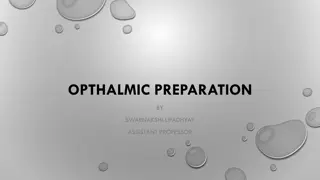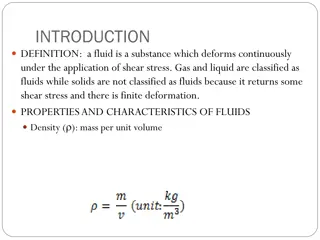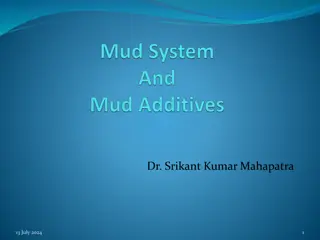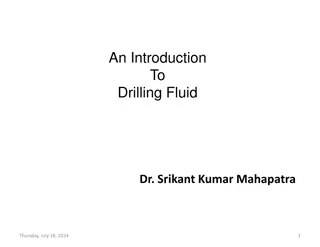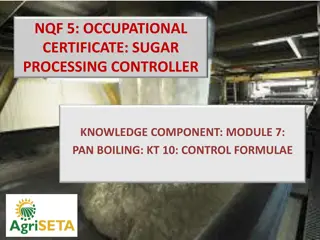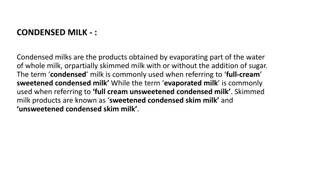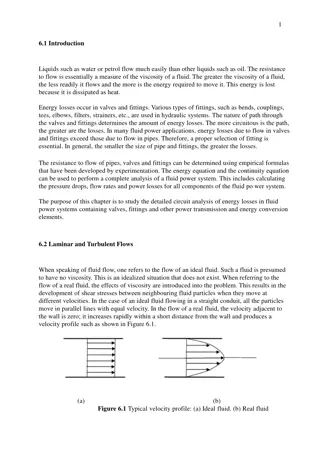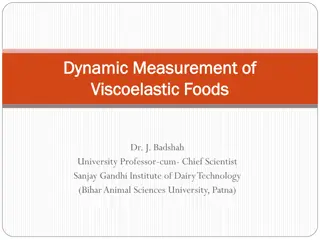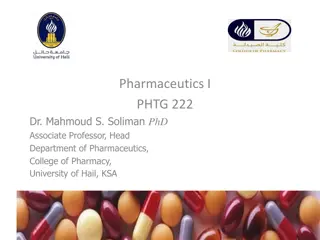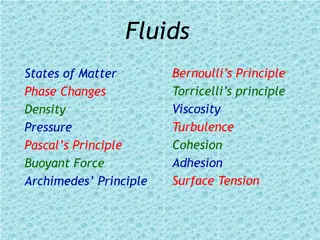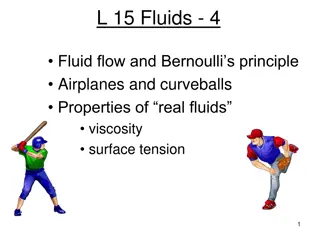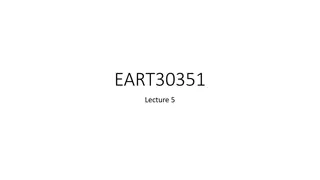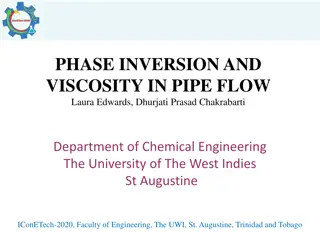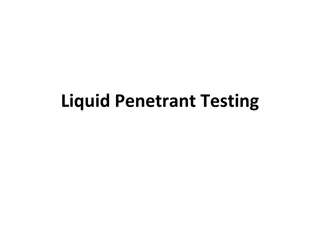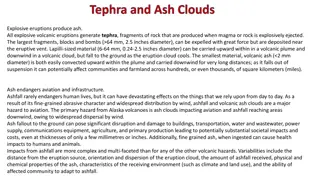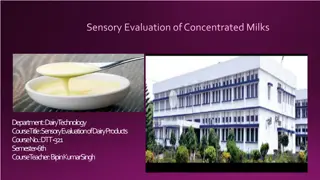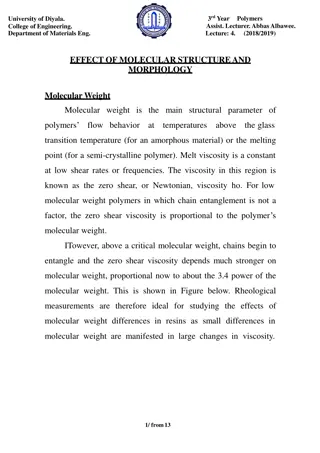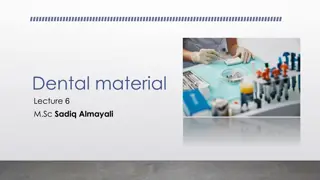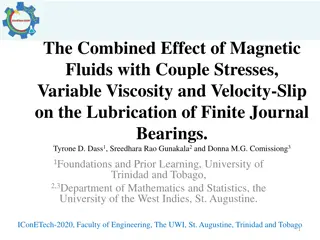OPTHALMIC PREPARATION
Ophthalmic preparations are essential for eye health, and their formulation requires careful consideration of factors like tonicity, pH adjustment, viscosity-imparting agents, stabilizers, antioxidants, surfactants, and preservatives. The goal is to ensure stability, bioavailability, and efficacy wh
1 views • 14 slides
Understanding Properties and States of Matter in Physical Science
Matter is made up of elements that cannot be broken down further. Different mixtures have distinct properties, such as solutions, colloids, and suspensions. Physical properties like viscosity and density can be observed without changing the material's composition. Chemical properties, like flammabil
2 views • 15 slides
Understanding Fluid Properties and Characteristics
A fluid is a substance that deforms continuously under shear stress, with gas and liquid classified as fluids. This article discusses key properties of fluids such as density, specific volume, specific weight, specific gravity, viscosity, pressure, surface tension, and stress. Understanding these ch
1 views • 4 slides
Understanding Inhibited Mud Systems in Drilling Operations
Inhibited mud systems play a vital role in drilling operations by repressing clay hydration and dispersion, offering advantages like higher clay concentration tolerance, reduced effects of contaminants, and better control of mud weight and viscosity. These systems are categorized into different type
0 views • 36 slides
Understanding Cosmetic Dosage Forms in the Beauty Industry
Solutions, emulsions, and water-in-silicon formulations are essential cosmetic dosage forms with unique characteristics and applications. Solutions range from water-based to anhydrous, while emulsions offer versatility for delivering hydrophilic and hydrophobic ingredients. Water-in-silicon emulsion
2 views • 19 slides
Understanding Stabilizers in Dairy Technology by B.K. Singh
Stabilizers are key ingredients used in ice cream and related products to enhance viscosity, stability, texture, and shelf life. They help in preventing wheying off, controlling crystal growth, and maintaining product quality during storage. Various types of stabilizers, including proteins, plant ex
0 views • 15 slides
Understanding the Physico-Chemical Properties of Cream
This informative material delves into the physico-chemical properties of cream, covering aspects such as viscosity, whipping quality, titratable acidity, specific gravity, and factors influencing viscosity. It discusses the influence of fat content, temperature, homogenization, cooling, aging, and c
0 views • 8 slides
Understanding Drilling Fluid Functions and Requirements
Drilling fluid plays a crucial role in the success of drilling operations by fulfilling various functions such as preventing hole collapse, controlling formation pressure, and maintaining wellbore stability. The fluid must effectively remove drill cuttings, cool and lubricate the drill string, and t
1 views • 41 slides
Understanding Fluorescence Analysis in Pharmaceutical Sciences
Fluorescence analysis is a crucial technique in pharmaceutical analysis, involving the emission of radiation by molecules when excited at specific wavelengths. Factors influencing fluorescence, such as concentration, light intensity, adsorption, oxygen presence, pH, temperature, viscosity, and photo
2 views • 26 slides
Sugar Processing Control Formulas and Parameters
Explore the key concepts of crystal content, exhaustion, and the SJM formula in sugar processing control. Learn how to calculate crystal content, manage viscosity limitations, maximize sucrose recovery, and apply the SJM formula for sucrose recovery percentage. Understand the factors affecting exhau
1 views • 8 slides
Understanding Condensed Milk: Types, Properties, and Manufacturing Process
Condensed milk is a dairy product made by evaporating water from whole or skimmed milk, with or without sugar. There are various types such as sweetened and unsweetened, each with specific requirements for milk fat content and sugar levels. The physico-chemical properties of condensed milk include f
2 views • 5 slides
Understanding Lubricants in Engineering Chemistry
Lubricants are substances introduced between moving surfaces to reduce friction, heat generation, and wear and tear of machine parts. They act as thermal barriers, coolants, seals, and corrosion inhibitors. Good lubricating oils have high boiling points, adequate viscosity, and non-corrosive propert
1 views • 25 slides
Synthesis of Acetylcysteine: Procedure, Uses, and Precautions
The synthesis of acetylcysteine involves acetylating L-Cysteine in the presence of acetic anhydride and sulfuric acid. Acetylcysteine has various uses, including reducing pulmonary secretions' viscosity, being an antidote for acetaminophen overdose, and chelating heavy metals. The procedure, precaut
0 views • 20 slides
Understanding Earth's Processes: Chapter 6 Clicker Questions
In Chapter 6, the focus is on the melting associated with the addition of carbon dioxide or water to rocks, magma composition, viscosity of hot mafic magma, and identification of pyroclastic flows. Explore these concepts through interactive clicker questions featuring informative images.
0 views • 11 slides
Marine Corps Expeditionary Fluid Analysis System (EFAS) Overview
The USMC Expeditionary Fluid Analysis System (EFAS) led by Mr. Anton Schager is a deployable, real-time fluid analysis system supporting Condition-Based Maintenance for Marine Corps ground equipment. It consists of two tiers - a ruggedized portable analyzer for tactical units and a benchtop analyzer
4 views • 12 slides
A Comprehensive Guide to Pump-able Primary Grout Mix Designs for Soft Ground Tunnelling Operations
This detailed guide covers the grouting technique used in soft ground tunnelling operations, focusing on stabilizing tunnel segments and reducing ground settlement by filling annular spaces with different types of grouts. It includes information on laboratory tests, trial mix designs, technical requ
0 views • 8 slides
Exploring Physical Characteristics and Density Relations in Inland Water Environments
Inland water environments exhibit unique physical characteristics such as pressure variations and density relations influenced by factors like temperature, pressure, and dissolved substances. Water's density changes with temperature and pressure, affecting its mobility and viscosity. Understanding t
0 views • 10 slides
Understanding Energy Losses in Fluid Power Systems
Liquids such as water and petrol flow more easily than oil due to viscosity differences. Energy losses occur in valves and fittings, and the selection of fittings is crucial to minimize losses. The chapter delves into in-depth circuit analysis, laminar and turbulent flows, and the concept of Reynold
2 views • 25 slides
Understanding Condensed and Evaporated Milk Products
Condensed milk is made by evaporating water from whole or skimmed milk, possibly with added sugar, while evaporated milk involves evaporating water from milk and sterilizing it. Standards for their fat and solids content are set by FSSR. Preparation involves varying steps like reception, cooling, fi
0 views • 15 slides
Synthesis and Uses of Acetylcysteine
Acetylcysteine is synthesized by acetylating L-Cysteine in the presence of acetic anhydride and sulfuric acid. It finds various uses, including reducing pulmonary secretions' viscosity, treating acetaminophen overdose, and acting as a chelating agent. The procedure involves precise steps and precaut
1 views • 10 slides
Understanding Dynamic Measurement of Viscoelastic Foods
Viscoelastic foods exhibit time-dependent properties that can be measured using oscillatory mode in viscometers like cone and plate or parallel plate viscometer. The shear stress under oscillating mode provides insights into the material's viscosity and elasticity. Characteristics such as Wissenberg
0 views • 7 slides
Pharmaceutical Suspensions: Definition, Formulation, and Applications
Pharmaceutical suspensions are dispersions of insoluble solid particles in a fluid medium, commonly aqueous. They offer benefits like increased drug stability, improved palatability, and ease of administration. Formulation considerations include homogeneity, re-suspension ability, particle size, and
1 views • 46 slides
Understanding Filtration: Process, Applications, and Mechanisms
Filtration is a process of separating solid particles or suspended matter from liquid or gas by passing it through a porous medium. This article discusses the definition of filtration, factors affecting its rate, applications in various industries, mechanisms involved, and different types of filtrat
1 views • 6 slides
Understanding Fluids, States of Matter, and Phase Changes
Exploring key concepts in physics including Bernoulli's Principle, viscosity, cohesion, states of matter (solid, liquid, gas, plasma), phase changes (evaporation, condensation, etc.), density, pressure, and more. Discover the properties and behaviors of fluids in relation to gases and liquids, along
1 views • 54 slides
Understanding Fluid Dynamics and Bernoulli's Principle in Real-world Applications
Explore the fascinating world of fluid dynamics with a focus on Bernoulli's principle through real-life examples like air flow in wind tunnels, airplane wings, and even tornado behavior. Discover how changes in fluid velocity affect pressure and how streamlines provide insights into fluid flow behav
1 views • 23 slides
Exploration of Thermodynamics in SU(3) Gauge Theory Using Gradient Flow
Investigate the thermodynamics of SU(3) gauge theory through gradient flow, discussing energy-momentum stress pressure, Noether current, and the restoration of translational symmetry. The study delves into lattice regularization, equivalence in continuum theory, and measurements of bulk thermodynami
0 views • 40 slides
Understanding Forces and Dynamics in Atmospheric Science
Exploring the forces acting on parcels of air in the atmosphere, including gravitational acceleration, pressure gradient acceleration, and viscosity. Delving into Lagrangian and Eulerian derivatives, advection, and transforming to a rotating frame with Coriolis effect. Enhance your knowledge of atmo
0 views • 14 slides
Everything You Need to Know About Castor Plant and Its Uses
Castor (Ricinus communis L.) is an ancient non-edible oilseed with significant industrial and medical value due to its high oil content, unique fatty acid composition, and various applications. India dominates world production, with China and Brazil also being important producers. Castor plants have
0 views • 22 slides
Investigating Phase Inversion and Viscosity in Pipe Flow
This study explores the effects of varying oil percentages on flow patterns, pressure drop, holdup, and viscosity in multiphase pipe flow. The research methodology includes testing rigs and applying theories for calculating liquid holdup and pressure drop. Results include insights into flow patterns
0 views • 19 slides
Understanding the Impact of Cold Weather on Sickle Cell Disease
Patients with sickle cell disease (SCD) often experience painful episodes known as sickle cell crises due to abnormally shaped red blood cells. The severity of SCD can be influenced by genetic and environmental factors, with cold weather being linked to increased pain episodes. Research has shown co
0 views • 27 slides
Understanding Liquid Penetrant Testing: Methods, Advantages, and Applications
Liquid Penetrant Testing (PT) is a non-destructive testing method used to detect surface flaws in various materials. This method involves applying a colored or fluorescent dye to the surface, revealing any defects through capillary action. PT is widely used due to its effectiveness in detecting crac
0 views • 21 slides
Understanding Volcanic Hazards: Tephra, Ash Clouds, and Lava Flows
Explosive volcanic eruptions produce tephra, fragments of rock that can be carried by volcanic plumes, ash clouds, and lava flows. Tephra, including blocks, bombs, and lapilli, poses aviation hazards, infrastructure disruptions, and health risks. Ashfall can impact communities and agriculture over v
0 views • 4 slides
Sensory Evaluation of Concentrated Milks in Dairy Technology
A comprehensive look into the sensory evaluation of concentrated milks in the dairy industry, focusing on the examination process of evaporated milk. Understanding the sensory attributes is crucial for product improvement and ensuring quality for consumers. The process involves assessing color, text
0 views • 16 slides
Finite Element Modelling of Three-Phase Non-Isothermal Flow in Heavy Oil Reservoirs - SAGD Case Study
Introduction to thermal enhanced oil recovery (TEOR) techniques with a focus on steam injection for heavy oil reservoirs. The study explores the impact of temperature on viscosity using API classification of crude oil. Mathematical models and equations for continuity and momentum in SAGD configurati
0 views • 15 slides
Understanding the Melting Process of Glass
The melting process of glass involves introducing a batch into a furnace at high temperatures for conversion into a glass melt through various chemical reactions such as decarbonation and dissolution. Initial heating releases moisture, and gas is released during decomposition, affecting homogenizati
0 views • 22 slides
Understanding the Influence of Molecular Weight on Polymer Flow Behavior
Molecular weight plays a critical role in determining the flow behavior of polymers above their glass transition temperature or melting point. The zero shear viscosity of polymers is directly related to their molecular weight, with significant changes in viscosity observed even with small difference
0 views • 13 slides
Understanding Viscous Fluid Behavior in Engineering Applications
Viscosity is a crucial property in fluid mechanics, impacting how fluids deform and move. Engineers measure viscosity using factors like resistance to deformation and fluid behavior classifications such as Newtonian, shear thinning, shear thickening, and Bingham plastic. This knowledge is essential
0 views • 7 slides
Understanding Density and Related Concepts in Physics
Explore the concept of density and related terms such as mass, viscosity, buoyancy, volume, and more in physics. Learn how to calculate density, understand mass and volume relationships, and solve problems involving the properties of different materials. Discover the principles behind buoyancy, visc
0 views • 35 slides
Understanding Rheology in Dental Materials
Rheology is a crucial aspect in dentistry as it deals with the flow properties of various dental materials, including liquids like molten alloy and impression materials. Viscosity plays a key role, determining how materials flow and behave. Different fluid classifications based on rheology, such as
0 views • 15 slides
Combined Effect of Magnetic Fluids and Variable Viscosity on Lubrication of Finite Journal Bearings
Study investigating the impact of magnetic fluids, couple stresses, variable viscosity, and velocity slip on the lubrication of finite journal bearings. The research focuses on pressure distribution, load-carrying capacity, and frictional coefficient in the context of tribology.
0 views • 19 slides
